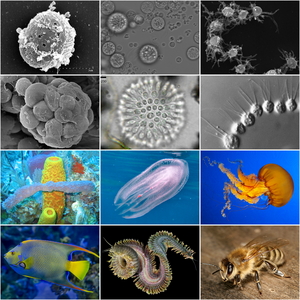
Back Holozoa Afrikaans بعديات صحيحة Arabic بعديات صحيحه ARZ Holozoa Bulgarian Holozoa BS Holozous Catalan Holozoa Czech Holozoa German Holozoa Spanish Holozoa Basque
| Holozoans Temporal range:
| |
|---|---|
 | |
| Holozoan diversity. Top half displays representatives of holozoan protists. Bottom half displays representatives of metazoans. | |
| Scientific classification | |
| Domain: | Eukaryota |
| Clade: | Amorphea |
| Clade: | Obazoa |
| (unranked): | Opisthokonta |
| (unranked): | Holozoa Lang et al., 2002[1] |
| Clades[4] | |
Incertae sedis | |
| Synonyms | |
| |
Holozoa (from Ancient Greek ὅλος (holos) 'whole', and ζῷον (zoion) 'animal') is a clade of organisms that includes animals and their closest single-celled relatives, but excludes fungi and all other organisms. Together they amount to more than 1.5 million species of purely heterotrophic organisms, including around 300 unicellular species. It consists of various subgroups, namely Metazoa (or animals) and the protists Choanoflagellata, Filasterea, Pluriformea and Ichthyosporea. Along with fungi and some other groups, Holozoa is part of the Opisthokonta, a supergroup of eukaryotes. Choanofila was previously used as the name for a group similar in composition to Holozoa, but its usage is discouraged now because it excludes animals and is therefore paraphyletic.
The holozoan protists play a crucial role in understanding the evolutionary steps leading to the emergence of multicellular animals from single-celled ancestors. Recent genomic studies have shed light on the evolutionary relationships between the various holozoan lineages, revealing insights into the origins of multicellularity. Some fossils of possible metazoans have been reinterpreted as holozoan protists.
- ^ Cite error: The named reference
Lang et al. 2002was invoked but never defined (see the help page). - ^ Cite error: The named reference
ChoanoEvowas invoked but never defined (see the help page). - ^ Cite error: The named reference
Strother 2021was invoked but never defined (see the help page). - ^ Cite error: The named reference
Adl 2019was invoked but never defined (see the help page). - ^ Cavalier-Smith, Thomas (2009). "Megaphylogeny, Cell Body Plans, Adaptive Zones: Causes and Timing of Eukaryote Basal Radiations". Journal of Eukaryotic Microbiology. 56: 26–33. doi:10.1111/j.1550-7408.2008.00373.x.
© MMXXIII Rich X Search. We shall prevail. All rights reserved. Rich X Search